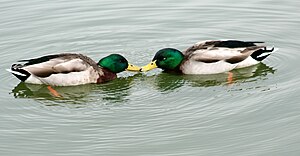Gaweng homosekswal sa mga hayop
Manlaenlaen na bakong tawong espesye nin hayop an nagpapahiling nin gawe na pwedeng interpretaron bilang sarong homosekswal o bisekswal.[1] Posibleng kabali digdi an pareho nin sekso na sekswal na aktibidad, courtship, affection, pair bonding, asin parenting among same-sex animal pairs.[2][3][4][5] Manlaenlaen na porma kaini iyo an nanompongan sa lambang mayor na heograpikong rehiyon asin sa lambang mayor na grupo nin hayop. An gaweng sekswal kan mga hayop na bakong tawo igwa nin manlaenlaen na mga porma, maski ngani sa laog kan parehong espesye, dawa ngani an gaweng homosekswal midbid na marhay huli sa sosyal na espesye.

Toltolan baguhon
- ↑ Yeoman, Barry (2023-07-04). "Same-Sex Behavior Among Animals Isn't New. Science Is Finally Catching Up". National Wildlife Federation. Retrieved 2024-03-09.
- ↑ Braithwaite, L. W. (1981). "Ecological studies of the Black Swan III – Behaviour and social organization". Wildlife Research (Canberra, Australia: CSIRO) 8: 134–146. doi:.
- ↑ Bailey, N. W.; Zuk, M. (August 2009). "Same-sex sexual behavior and evolution". Trends in Ecology and Evolution 24 (8): 439–46. doi:. PMID 19539396.
- ↑ "Same-sex Behavior Seen In Nearly All Animals, Review Finds". ScienceDaily (Press release). June 17, 2009.
- ↑ Vernick, Daniel (2023-06-28). "Are there queer animals? Clownfish that change sex, and other species that demonstrate queer behavior". World Wildlife Fund. Retrieved 2024-03-09.